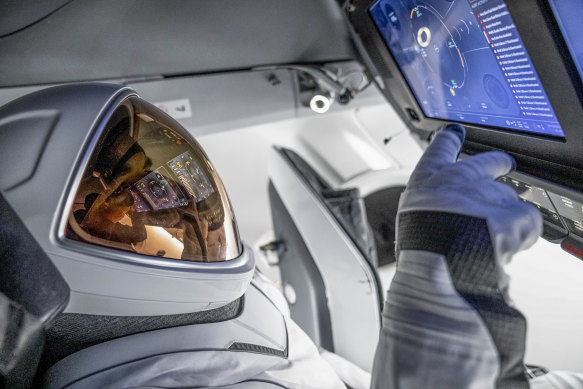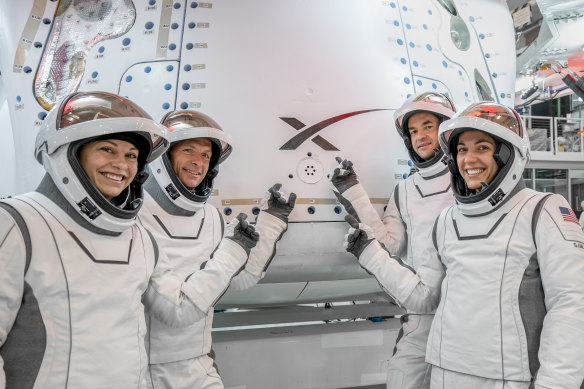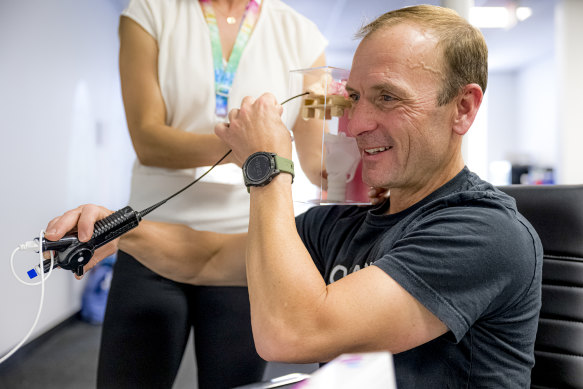This was published 10 months ago
A billionaire adventurer returns to space, this time on a riskier mission
By Kenneth Chang
Three years ago, a billionaire entrepreneur named Jared Isaacman made a groundbreaking trip to space. That space flight, which Isaacman called Inspiration4, was the first to orbit Earth without a professional astronaut aboard.
This week, Isaacman, founder and CEO of Shift4, a payment processing company, is scheduled to head into space again. This time the itinerary is longer, more daring and riskier, and includes a spacewalk, the first by private astronauts.

A test of the spacesuit inside the Dragon capsule. Jared Isaacman, founder and chief of the company Shift4, is leading three other privately trained astronauts on a SpaceX vehicle for Polaris Dawn, a mission that will include a daring spacewalk. Credit: SpaceX via The New York Times
The mission, named Polaris Dawn, hearkens back to the earliest era of spaceflight, the 1960s, when pioneers including Yuri Gagarin of the Soviet Union and John Glenn of the United States pushed the boundaries of what had been accomplished in space, learning how to survive and operate in an airless and weightless environment.
But unlike those expeditions, undertaken by national space agencies, this is a purely commercial effort. For Polaris Dawn, Isaacman is collaborating closely with Elon Musk and his rocket company, SpaceX, to start laying the foundations for Musk’s dream of sending people to Mars.
“There’s always a risk calculus to it,” Isaacman said in an interview a week and a half ago, before he and his three crewmates headed to Florida for the launch. “But the real focus is on what we stand to gain and learn from it. And in this case, we’ve got some pretty cool things.”
Most astronaut missions these days are almost boringly routine, basically taxi rides ferrying people to and from an orbiting space station.

Members of the Polaris Dawn crew (from left): Anna Menon, a SpaceX engineer; Scott Poteet, a retired US Air Force pilot; Jared Isaacman, founder and chief of the company Shift4; and Sarah Gillis, who oversees astronaut training at SpaceX.Credit: SpaceX via The New York Times
The Polaris Dawn mission is not going to a space station. Instead, it is going further than anyone has travelled since the Apollo 17 mission went to the moon in 1972.
“It’s time to explore,” William Gerstenmaier, a former NASA official who is now vice president for build and flight reliability at SpaceX, said during a news conference on August 19.
A SpaceX Falcon 9 rocket will launch a Crew Dragon capsule – the same spacecraft that takes NASA astronauts to the International Space Station, or ISS – into an elliptical orbit that swings much further away from Earth. Polaris Dawn astronauts will pass through regions of intense radiation, and risk bombardment from tiny space rocks as well as bits of human-made debris that could puncture the spacecraft.
The upside of the journey is that it will test new technologies and gather data on the effects it has on the human body when people venture deeper into space.
“This is a mission that sets out to accomplish a lot of things in a very short period,” Isaacman said. “We have some pretty ambitious objectives.”
For this flight, SpaceX developed a new spacesuit to be used for the spacewalk, and will also try sending communications via laser pulses, instead of radio signals, between the Crew Dragon and SpaceX’s Starlink constellation of internet satellites.
Polaris Dawn is scheduled to lift off from NASA’s Kennedy Space Centre early on Tuesday, during a four-hour launch window that opens at 3:38am.
While Isaacman led and financed Inspiration4 – he essentially chartered a flight using a Falcon 9 rocket and a Crew Dragon capsule from SpaceX – Polaris Dawn and two subsequent missions are, in Isaacman’s words, a “joint effort” between Isaacman and SpaceX.

Scott Poteet, a retired US Air Force pilot, during training for the Polaris Dawn mission. Poteet underwent surgery to implant a device that would measure the pressure of the fluid in his skull. Credit: John Kraus/Polaris Program via The New York Times
Isaacman declined to say how much he or SpaceX has spent. “We don’t ever get into the costs on all this,” he said. “I would just say that there is obviously a lot of contributions that are coming from SpaceX, and myself, in this.”
Two members of the Polaris Dawn crew are SpaceX employees: Anna Menon, a lead space operations engineer, and Sarah Gillis, who oversees astronaut training.
The other two crew members are Isaacman and Scott Poteet, a retired US Air Force pilot and long-time friend of Isaacman’s who served as the mission director on the ground during Inspiration4.
Polaris Dawn will travel further from the planet that anyone since the Apollo moon landings ended more than 50 years ago. The first few orbits will pass through a dent in the Earth’s magnetic field known as the South Atlantic Anomaly; this magnetic weak spot allows high-energy charged particles from regions known as the Van Allen belts to come much closer to Earth’s surface.
Within a few hours, the Polaris Dawn crew will receive a dose of radiation equivalent to what astronauts on the ISS absorb in three months.
After the Crew Dragon completes about eight orbits, the spacecraft’s thrusters will fire to push the apogee, or furthest point of the orbit, to 1400 kilometres above the planet.
That will be about 27 kilometres higher than the 1372-kilometre altitude NASA astronauts Pete Conrad and Richard Gordon reached during the Gemini 11 mission in 1966, still the record for astronauts on a space flight that did not head to the moon.
After about six of these high orbits, the Crew Dragon will fire its thrusters again to drop the spacecraft down to a lower, elliptical orbit, with an apogee of 700 kilometres.
The highlight of the five-day journey is scheduled for the third day: the spacewalk. During the two-hour operation, the astronauts will put on their spacesuits before all the air is let out of the Crew Dragon; the inside of the spacecraft will become part of the vacuum of outer space.
Then two crew members – Isaacman and Gillis, connected by umbilical cords that will provide power, air and other life support needs – will move outside the spacecraft to conduct tests on the spacesuits.
Poteet and Menon will remain inside the capsule, keeping an eye on the displays and managing the umbilical cords, but “taking all the same risks we are in the vacuum of space,” Isaacman said.
When Isaacman first announced a series of three space missions in February 2022, he said Polaris Dawn would take place by the end of that year. But the date slipped repeatedly as SpaceX engineers studied how to make the flight as safe as possible.
“At this point, there is no stone that they haven’t turned to make sure that we’re thinking about absolutely everything we can,” Gillis said.
The new technologies needed for Polaris Dawn went through numerous iterations and tests.
Isaacman recalled that he and Gillis had gone to NASA’s test facility at White Sands, New Mexico, to observe small projectiles fired at the spacesuits to see how they would stand up. “We obviously weren’t in them,” he said, “but to see how the suit performs in a micrometeorite environment.”
To help ensure that the spacewalk will go smoothly, the entire Crew Dragon capsule was placed in a large vacuum chamber, simulating the emptying of air that will be performed before the spacewalk, and then refilling the capsule with oxygen and nitrogen after the hatch was closed again.
Crew members acknowledge that risks remain, but said that they and the 14,000 employees at SpaceX had done everything they could to be ready to handle them.
“The first time we got into the simulator and we had to work as a crew, it went horribly wrong,” Gillis said. “We had so much to learn because we weren’t able to yet work as a team.”
She added, “One of my most favourite parts of this journey is actually figuring out how we bring together these incredible skill sets to build a team that can go execute on these objectives and be successful as a team.”
The crew will conduct about 40 experiments, including obtaining magnetic resonance images of the astronauts’ brains and attempting to take X-ray images without an X-ray machine by using the natural showers of radiation that stream through outer space.
“We’re going to spend every waking moment on orbit addressing these issues so we can capitalise on this opportunity,” Poteet said.
Poteet even underwent surgery to implant a device that was to measure the pressure of fluid around his brain. As astronauts float in orbit, fluids within their bodies shift upward, which may increase pressure inside their skulls, a potential cause of the squashed eyeballs, swollen optic nerves and blurred vision some astronauts have experienced.
However, the device was removed. “It was an experimental surgery,” Poteet said. “That particular device just didn’t work out.”
The five-day mission will end with a splashdown off the coast of Florida.
The crew will be thinking about their families during the voyage.
“I think often they have the hardest job while we’re on this endeavour,” Menon said. “One way that I have been connecting with my family on this journey is I wrote a children’s book named Kisses from Space.”
She and her co-author, Keri Vasek, wanted to tell “a story about the power of love to overcome any distance,” Menon said. “And it’s the story that I wrote for my kids on this journey, and I’ll have the chance to read it to them from space.”
This article originally appeared in The New York Times.
Get a note directly from our foreign correspondents on what’s making headlines around the world. Sign up for our weekly What in the World newsletter.